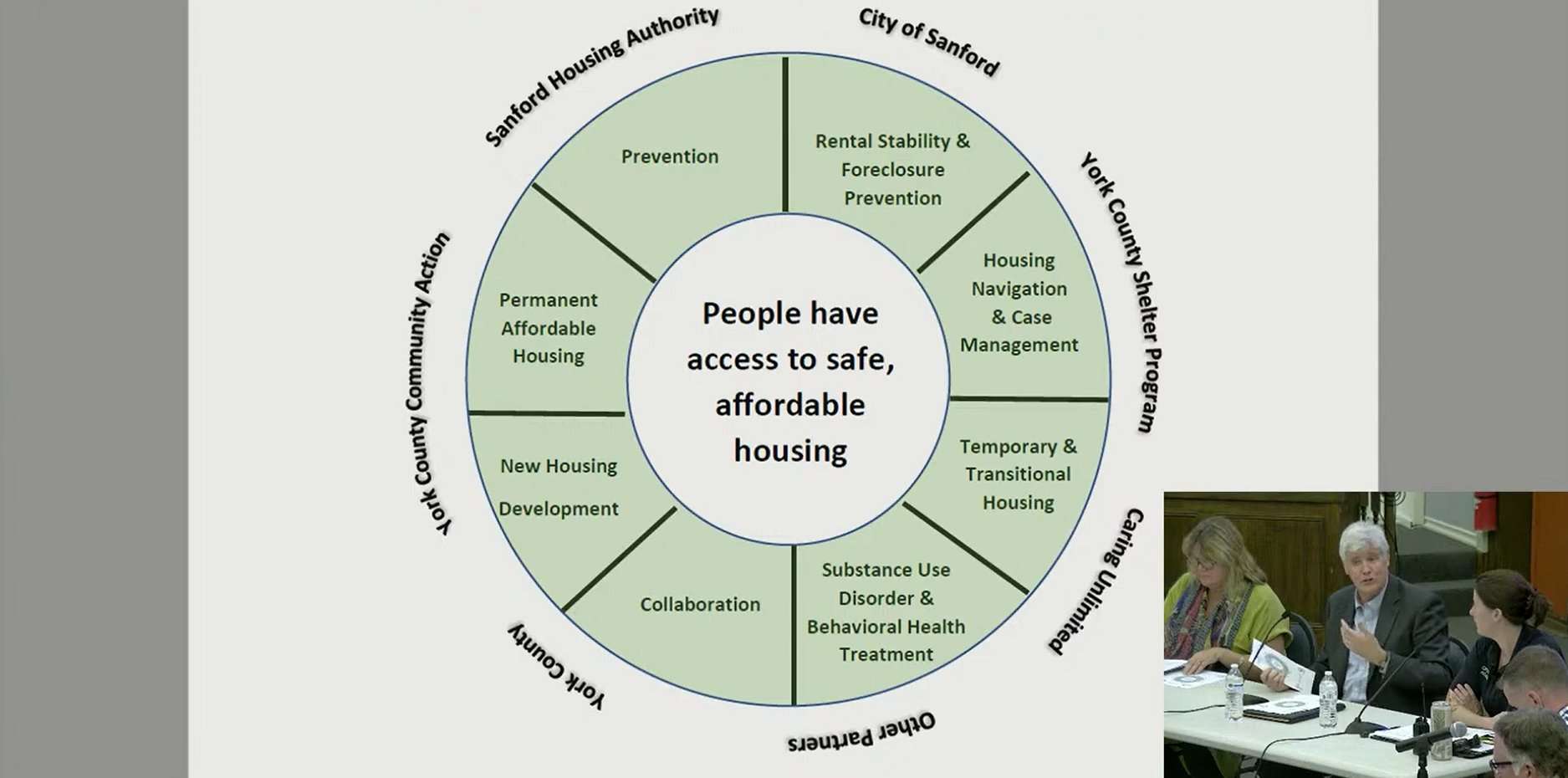Collaboration the Key to Finding Housing for Sanford’s Homeless

Participants in the City Council’s Housing Workshop on September 28, 2022, stressed that the collaboration between their agencies, and between the agencies, the City and the School Department, is the main reason why Sanford has been able to successfully find housing for many vulnerable people in our community, and help others to stay in their homes.
The goal of this workshop was to offer the Council, the City Manager and the public a high-end view of the collaborations between participating agencies in Sanford/Springvale in finding solutions to housing for all, and an overview of the initiatives currently taking place to address the housing crisis in our community through a continuum of housing. A panel of representatives from key organizations that are actively addressing housing issues in our community shared information and discussed questions and comments from the Council.
The workshop was chaired by Mayor Anne-Marie Mastraccio and Diane Gerry, Executive Director of the Sanford Housing Authority (SHA). The panel also included:
- Bonnie Gagnon, Director of Residential Services, Caring Unlimited
- Steve Bussiere, Assistant Superintendent, Sanford School District
- Carter Friend, Executive Director, York County Community Action Coalition (YCCAC)
- Megan Gean-Gendron, Executive Director, York County Shelter Programs
- Officer Colleen Adams, Sanford Police Department, Mental Health Unit
Mr. Friend kicked off the discussion by talking about the context and causes of the current housing crisis. The number one problem, he said, is that there are not enough housing units in general and not enough affordable units specifically. The main cause of this shortage is that over the past ten years the production of new housing units has not kept up with the need. Barriers to building include the cost of materials and land, the labor shortage and land use regulations.
The second problem is the pressures on the housing market. He said the first of these pressures is the significant increase in investors purchasing properties, renovating them and reselling them at a higher price. This has led to fewer affordable homes being available for lower income buyers. Just in the past year, the number of single-family homes purchased by investors nationally has risen from 19% to 28%, about the same as it is in Sanford. Another pressure is the growth in the number of people age 25-30 who have been living at home and now want their own homes. The third factor is that people who in the past would have moved from renting a home to purchasing one, are not able to purchase one due to the shortage of homes affordable to first-time buyers.
Mr. Friend said the recent increase in mortgage rates has had a big impact on affordability. A 2% increase in interest is equal to a 27% increase in the home price. Inflation has also made the overall cost of living higher, which in turn restricts the ability of seniors and others on fixed incomes to stay in their homes.
Ms. Gerry said a study by Maine Housing showed that 19,000 new housing units are needed in the state to meet the current demand. Fortunately, in Sanford and Springvale, she said, market-rate units currently being planned and built will help to move the continuum of housing along. She is hopeful that some of the new units will take housing vouchers.
The shortage of housing and the pressure on the market has led to a big increase in rents in southern Maine. The Sanford Housing Authority’s owns its own public housing, but the Section 8/Housing Choice Voucher program (HCV), which hundreds of Sanford residents rely on, has seen the number of landlords who will accept vouchers drop significantly, as they have no trouble finding tenants who will pay a higher rent. Ms. Gerry said SHA has responded by increasing its payment standard from 90% of fair market rent to 110% to be more competitive. Landlord incentive programs have also been instituted (see this story).
Ms. Gean-Gendron lightened the mood a little by recounting a recent success story that involved her agency. A man from Sanford had a medical issue that caused him to lose his job, and with it his health insurance and his home. He came to YCSP for emergency shelter and they were able to work with him to get him MaineCare and get his medical issue treated. Following that he was able to get his old job and health insurance back. He was on a housing voucher with SHA for a year until he could afford to pay full rent, and now owns a home of his own.
Mr. Bussiere related how the School Department assists homeless students and their families. Teachers and other staff members are able to spot when a student is struggling and the Department’s outreach workers help the family get into shelter and get counseling and other needed services. He said one thing that is new is they are seeing working people having their rental housing sold, and rents raised to a point that is unaffordable. He said community members are being forced out because of the crisis.
Ms. Gagnon provided another success story about a domestic violence survivor who came to Caring Unlimited and they were able to get her into transitional housing. She also needed medical care and that was provided through Nasson Health Care, which is part of YCCAC. The woman got her driver’s license and a car through the Freedom Wheels program. She is working now and by next spring will no longer need a housing voucher.
Ofc. Adams talked about the Mental Health Unit’s assistance to a disabled local resident who called 911 many times. They were able to determine that he was suffering anxiety because his mortgage payment was more than his disability check. With help from the MHU and YCCAC, he qualified for emergency housing assistance and is now working on his mental health and medical issues.
Mr. Friend showed a wheel-shaped diagram (see above) illustrating the strategies that the City, the SHA and the other agencies employ to provide access to safe, affordable housing. Each one of the agency representatives then went through the pieces of the wheel they provide and how they overlap and collaborate with each other to find housing for people or keep them in their homes.
In addition to Nasson Health Care, rent relief and foreclosure prevention, YCCAC’s programs include heating assistance, home repair assistance, tax assistance and home buyer education.
Ms. Gean-Gendron talked about the York County Food Pantry, which YCSP runs out of a building in Alfred, so that low-income residents don’t have to choose between buying food or paying rent. The Pantry distributes about 150 boxes of food each Tuesday and Friday, but its rural location is inaccessible for many who need it. She said one of YCSP’s priorities is finding a funding partner for a mobile food pantry.
Mr. Bussiere mentioned the School Department’s collaboration with the Sanford Backpack Program. He also talked about how the Department works to keep Sanford kids in Sanford schools, even if they have to temporarily move to a new school district. His office works with the other district to find existing transportation options, and if new transportation has to be provided, the districts split the cost. He stressed the importance of educational stability in a child’s life.
Ms. Gagnon said as Director of Caring Unlimited, she works with SHA as well as the School Department to get services for families, but also relies on the Police Department, YCSP and YCCAC. She networks with local landlords who offer their vacant apartments for her clients.
City Council members had many questions and comments throughout the workshop. Councilor Mike Termath asked what services are available specifically for homeless veterans. Mr. Friend responded that YCCAC’s outreach staff works with veterans, and the agency’s transportation department has a service focus on vets. Councilor Becky Brink asked what the School Department does if a student shows up at school with no place to go that night. Mr. Bussiere said they are forming a committee to develop a list of host families, but right now they depend informally on caring staff members who will provide temporary shelter in their own homes. They want to formalize that process, he said.
Councilor Bob Stackpole asked what more the City Council can do to help with the housing crisis locally. Mr. Friend said it’s all about constructing more housing units. Ms. Gean-Gendron reported that two families have been in YCSP’s shelter for over a year waiting for three-bedroom units that accept vouchers to become available, but that rental housing of all sizes is badly needed.
City Manager Steve Buck emphasized the Council’s investment in the Land Bank has been key to bringing vacant housing back into use, and mentioned the workforce housing projects that are in the pipeline. He also praised the work of the Mental Health Unit. “I hope the community realizes that there is a concerted effort to address housing and homelessness,” he concluded.
The full workshop video is available to view on Town Hall Streams here and on YouTube here.






